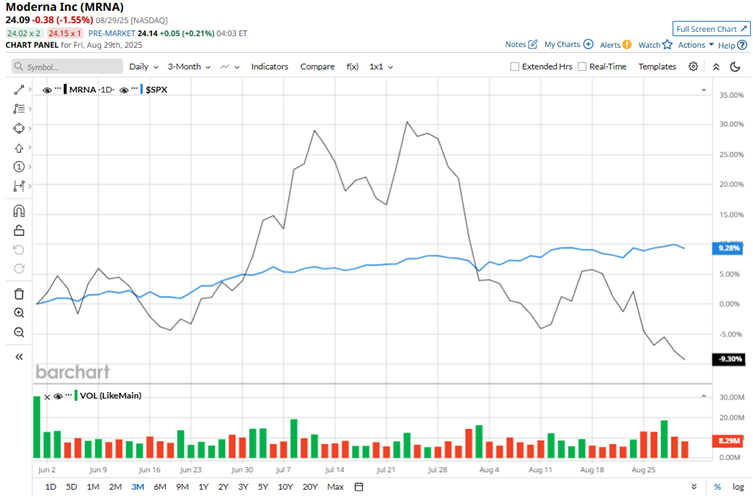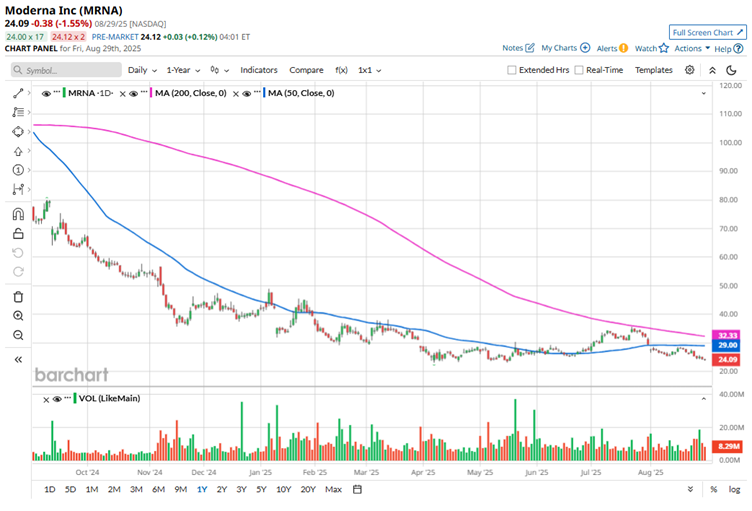|
|
|
|
LeRoy Coop
Departments
Cash Bids
Market Data
News
Ag Commentary
Weather
Resources
|
Is Moderna Stock Underperforming the S&P 500?/Moderna%20Inc%20meds-by%20Ascannio%20via%20Shutterstock.jpg)
With a market capitalization hovering around $10 billion, Massachusetts-based Moderna, Inc. (MRNA) is a clinical-stage pharmaceutical company focused on developing messenger RNA (mRNA)–based therapies. Leveraging mRNA technology, Moderna is revolutionizing the way medicines are developed, enabling the faster creation of treatments and vaccines for a range of diseases. Over more than a decade, the company has advanced therapies at a notable speed, including one of the first widely used COVID-19 vaccines. Companies valued at $10 billion or more are typically classified as "large-cap" stocks, and Moderna sits near this threshold. The company’s mRNA platform supports research and development in infectious diseases, immuno-oncology, rare diseases, and autoimmune conditions. Backed by a global team guided by its core values, Moderna continues to push the boundaries of how science and technology intersect with human health. However, despite its efforts in the healthcare space, MRNA has faced a turbulent ride on Wall Street. The stock has tumbled nearly 70% from its 52-week high of $79.96 hit last September, reflecting investor caution amid sector volatility. Over the past three months, MRNA has dropped about 10.6%, sharply lagging the broader S&P 500 Index ($SPX), which gained 9.3% in the same period. 
The longer-term performance paints an even bleaker picture for Moderna. Over the past year, the stock has shed nearly 69.3% and has continued to slide in 2025, falling roughly 42.1% year-to-date (YTD). By comparison, SPX has climbed 15.5% over the past year and is up 9.8% so far in 2025. The bearish trend in Moderna’s stock is hard to ignore. Since last September, the shares have consistently stayed below their 200-day moving average, a key long-term indicator of market sentiment. On a shorter-term basis, MRNA has also remained under its 50-day moving average for most of this period, with only occasional, brief upticks that failed to sustain momentum. 
The sharp decline in demand for Moderna’s COVID-19 vaccine has been the main culprit behind its stock slump. After soaring during the pandemic on the strength of its breakthrough mRNA vaccine, the company is now adjusting to a seasonal vaccine market, a shift that has put significant pressure on the company’s topline. The slowdown was pretty much evident in its fiscal 2025 second-quarter results, announced on Aug. 1, which triggered a 6.6% sell-off. Revenue for the quarter came in at $142 million, representing a significant 41% decline from $241 million in the same period last year, primarily driven by weaker COVID vaccine sales of $114 million. Looking ahead, management expects demand to pick up in the second half of the year, in line with the fall and winter seasons, as the vaccine moves firmly into its role as a seasonal respiratory product. On the other hand, Moderna’s peer Exelixis, Inc. (EXEL) has charted a very different course, not only outperforming Moderna but also leaving the broader market in the dust. Over the past 52 weeks, EXEL has surged an impressive 45%, showcasing strong investor confidence. The momentum has carried into 2025 as well, with the stock up 12.5% YTD. With Moderna still stuck deep in the red, Wall Street seems to be adopting a cautious wait-and-see stance. Among the 27 analysts covering the stock, the consensus rating sits at a lukewarm “Hold.” The average price target of $41.81 implies almost 73.6% upside from the current level. On the date of publication, Anushka Mukherjee did not have (either directly or indirectly) positions in any of the securities mentioned in this article. All information and data in this article is solely for informational purposes. For more information please view the Barchart Disclosure Policy here. |
|
|